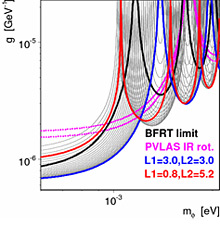Cosmic Frontier
GammeV

The 10 members of the GammeV experiment formed their collaboration in April, 2007, to investigate a claim that an Italian experiment called PVLAS had discovered an axion-like particle. The axion is a hypothetical particle that could cause light to behave strangely in a magnetic field, causing its polarization to rotate. It is one of the primary candidates for dark matter.
In the first phase of the experiment, physicists shot a laser through a magnet onto a mirror. The mirror was mounted on a welded cap that blocked all light. They wanted to know whether a particle of light, or photon, could be converted into an axion particle that could pass through the mirror and light-tight cap and become a photon again on the other side.
They fired the laser 6 million times in search of the new particle, which statistically should have appeared hundreds of times as regenerated photons. But they found no evidence that the light passed through the cap. This refuted the claims of the PVLAS experiment.
In its second run, the GammeV experiment searched for chameleon particles, hypothetical particles the properties of which are determined by their environment. Physicists theorize these particles may be responsible for dark energy. The experiment searched for chameleon particles by looking for a glow they should emit when they become trapped in a region with a high magnetic field and slowly decay into detectable photons. The collaboration did not observe a glow in this run of the experiment.
Members of the collaboration would like to upgrade their original axion study for the detector's third run.


